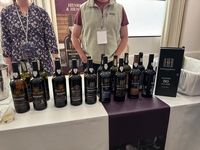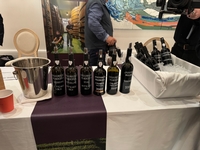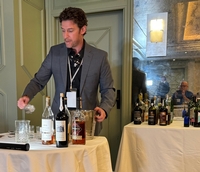 decades or longer. Most often, people think dessert. Madeira can be all these things – and more, as I learned at the Madeira Wine Experience in Los Angeles in October.
decades or longer. Most often, people think dessert. Madeira can be all these things – and more, as I learned at the Madeira Wine Experience in Los Angeles in October.
Madeira the place is the largest (about 286 square miles) and most populated (about 250,000) island in the Madeira Archipelago which includes the islands of Porto Santo and the Desertas. Though it’s closer to Morocco, it’s one of two Autonomous Regions of Portugal. It was claimed by the Portuguese in 1419, though it may have been visited by Norse explorers as early as 900 AD. It’s in a subtropical climate, characterized by dry Mediterranean style summers and wet winters – perfect for growing grapes. Except for the fact that it was covered in trees (“madeira” means “wood”) – which led the original settlers setting fire to virtually the entire island to make agriculture possible.
Today a fair portion of the island is terraced for growing grapes and other agricultural products – approximately 1175 acres are under vine. For reference, the Napa Valley AVA covers about 192 square miles and has about 45,000 acres under vine. Within that 1175 acres, there are approximately 2000 growers, and they mostly sell their grapes to six main producers. We’re talking small production! The grapes grown included Sercial, Verdelho, Boal, Malvasia, Tinta Negra, Bastardo and Terrantez, a traditional Madeira variety that was nearly extinct but is being revived by a few growers at the behest of one producer.
Once fruit gets to the producers, the process for making Madeira is unique in the world of wine. After initial fermentation is complete the wine is fortified with grape brandy, racked to barrel and then made to “cook” under heat, forcing oxidation and other chemical processes. It is thought that this cooking process came about by a happy accident, when a barrel shipped across the sea was returned unsold, having  baked in the sun for weeks, and found to have become an entirely different animal, so to speak. While we use the term “maderized” to indicate a fault of oxidation in regular table wines, in Madeira it’s not a fault – it’s a highly desirable characteristic.
baked in the sun for weeks, and found to have become an entirely different animal, so to speak. While we use the term “maderized” to indicate a fault of oxidation in regular table wines, in Madeira it’s not a fault – it’s a highly desirable characteristic.
Today, the cooking process is more controlled. Two methods are used. Estufagem – a high speed, carefully controlled method uses large heating tanks to force heat the wine at temps between 113° and 122° Fahrenheit for at least 90 days before going to barrel. This method is used for wines meant to go to market quickly and typically spend five years or less in barrel. The more traditional Canteiro method goes straight to barrel after fortification and spends a minimum of two years there on the higher racks in the barrel room where the temperatures typically fluctuate between 68° and 95° Fahrenheit. Wines can be bottled at that point, or at any point along the way. Some wines spend several years or even decades in barrel before bottling.
After tasting several examples, it seems that the time in the barrel is where the magic happens. To explain in somewhat simplistic terms, as the wine sits in the barrel “cooking,” in addition to oxidation, evaporation is occurring, meaning that water and alcohol are leaving the solution while sugar and acidity are becoming more concentrated. Barrels are also topped off periodically with another barrel (imaging 50 barrels of wine, with one used to keep the others full along the evaporation process) concentrating things even further. So, the wine is incrementally becoming more dense, more sweet, and more acidic as time passes. Consequently, it’s possible to end up with a wine with vibrant acidity that tames sweetness, making an old wine seem incredibly fresh and vibrant.
The wines are typically labeled by age, and different labelling can give you some clues as to contents and processes used. Blended wines can be labeled by age i.e., 5-year-old, 50-year-old, etc., and single variety wines may specify on the bottle, along with an aging/process indicator. Vintage dated Colheita signifies a minimum of 5 years in barrel and may specify a single variety, and Frasqueira indicates a minimum of 20 years in barrel and may specify a single variety. The varieties tend to indicate sweetness levels, with Sercial, Verdelho, Boal, Malvasia, Tinta Negra, Terrantez and Bastardo listed here in roughly dry to sweet order.
This variation leads us to the fact that the production methods utilized don’t dictate that all finished Madeira need be sweet. In similar fashion to sherry, there are all sorts of levels of sweetness, from very dry to wildly sweet, which, as any Madeira salesperson would tell you, makes Madeira capable of running the table from appetizers to dessert and everything in between. I was quite pleasantly surprised by a food pairing demonstration that showed that there can be a Madeira for just about any food, from seafood appetizers to burgers to sweet desserts. You can find a Madeira to suit just about anything you’d like to eat. I was particularly impressed by the Broadbent 10-Year-Old Boal paired with a savory burger, as well as the D’Oliveira 1994 Malvazia with a coffee & lucano cream puff. TECH GEEK ALERT: The ’94 D’Oliveira is particularly demonstrative with its numbers: Bottled in 2022 at 20.54% alcohol, 505 Baume (specific gravity) 13.2% residual sugar, .971% TA and .117 VA.
Madeira isn’t done with just the table either – it can be an exciting component in cocktails. Think of it as a complex mix in or something to add a twist to a riff on a classic tipple. Stylistically, think of it like sherry, but with a lot more acidity that can add a brightness that sherry lacks. It shines in stirred drinks in particular, but don’t be afraid of a little shaking either – it’s more than up to the task.
Los Angeles area Mixologist Camron Roberts demonstrated several  possibilities – I especially enjoyed his riff on a Negroni which he called a Negroni Rocha, featuring Broadbent Reserve 5-Year-Old Madeira, Campari, reposado tequila and pear brandy. For something simple, try a Rainwater (a particular dryer style) Madeira and Brandy highball. The beauty of Madeira on your bar is that it doesn’t spoil like vermouth or liqueurs with similar alcohol levels – you can leave a bottle of Madeira on the bar with no fear of it going bad before it is used up. If you don’t mind a fruit fly or two, you don’t even need to recork it.
possibilities – I especially enjoyed his riff on a Negroni which he called a Negroni Rocha, featuring Broadbent Reserve 5-Year-Old Madeira, Campari, reposado tequila and pear brandy. For something simple, try a Rainwater (a particular dryer style) Madeira and Brandy highball. The beauty of Madeira on your bar is that it doesn’t spoil like vermouth or liqueurs with similar alcohol levels – you can leave a bottle of Madeira on the bar with no fear of it going bad before it is used up. If you don’t mind a fruit fly or two, you don’t even need to recork it.
Which brings us to age-ability. Madeira is that rare beverage that has a fairly low alcohol volume that won’t go bad. While younger, dry style examples can easily sit open for 180 days with no perceptible decay, the longer aged wines are frozen in time, marking history like no other beverage. You’ve likely been regaled by a friend about their experience with a Madeira from as far back as the 1700’s, when it was the preferred beverage in America. (It is said that the Declaration of Independence was toasted with Madeira, as was George Washington’s inauguration as the first US President.) While these wines are largely gone now, there are long aged examples still floating around the marketplace – just be careful with provenance before dropping a large sum on one. Meanwhile, enjoy what’s more widely available – they are quite reasonably priced for what they have to offer, and they are certainly one of the most unique things that you’ll ever taste.
Special thanks to Allison Levine of Please the Palate for putting this event on my radar so that I could share it with you. Until next time – Saúde!
